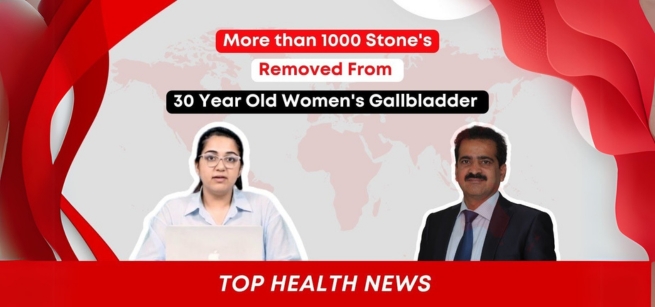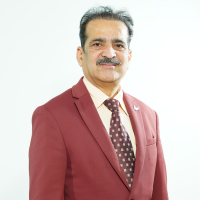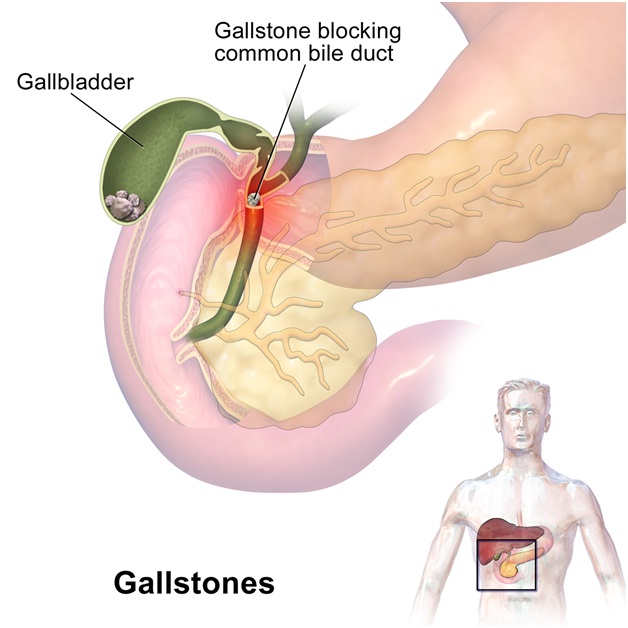
What is a Gall Bladder?
The gallbladder is a pear-shaped organ located below the liver on the right side of the abdomen which stores and stores the digestive juice known as bile fluid which is used to breakdown the dietary fats. The organ extracts water from its store of bile until the liquid becomes highly concentrated. The gallbladder is triggered to squeeze its bile concentrate into the small intestine via the common bile duct on the presence of fatty foods.
It is a misconception that bile is produced in the gall bladder. Bile is actually produced in the liver and then it is connected to the small intestine, duodenum by the common bile duct.
Gall bladder only stores a small amount of bile and connects to the common bile duct via a small tubular connection called the cystic duct.
Digestion can continue to be normal even in the absence of gall bladder and the bile duct can take over part of the function of the gall bladder.
What is Gall Bladder Stone?
Small, soft to hard, and stone-like substance made up of cholesterol, bile pigment and
calcium salts in the gall bladder are known as gallstones also known as biliary calculi. It
is condensation of the bile into tiny fragments which can come together and form stones.
It
is a common disease of the digestive or called the biliary system. The size of the gallstone
can vary from a small grain of sand to a size of the golf ball. Gall stones can be seen at
any age and are becoming more common.
Types of Gallstones
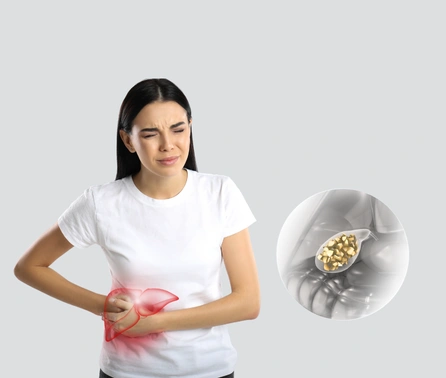
Effective Management of Mixed Gallstones
Mixed gallstones are the most common type of gallbladder stones, composed mainly of cholesterol and bile salts. These stones often form in multiple layers, meaning new stones can develop around existing ones, leading to a cluster of stones varying in size and shape. They are frequently linked to conditions such as obesity, pregnancy, and certain metabolic disorders. The formation of mixed gallstones can cause symptoms like pain, nausea, and digestive issues. Early diagnosis and treatment are important to prevent complications such as inflammation or infection of the gallbladder.
Get Appointment Watch Video Learn More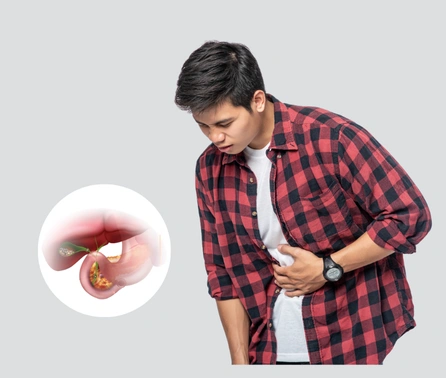
Managing Cholesterol Gallstones for Optimal Gallbladder Health
Cholesterol gallstones are yellowish-green stones primarily made up of crystallized cholesterol. They are the most common type of gallstones and typically develop when bile contains excess cholesterol that cannot be properly dissolved. These stones can vary in size and often grow quite large over time. Cholesterol gallstones are commonly found in individuals with high cholesterol levels, obesity, or certain metabolic conditions. They may cause symptoms like abdominal pain, nausea, or digestive discomfort. Early detection and appropriate treatment help prevent complications such as gallbladder inflammation or blockage of bile ducts.
Get Appointment Watch Video Learn More
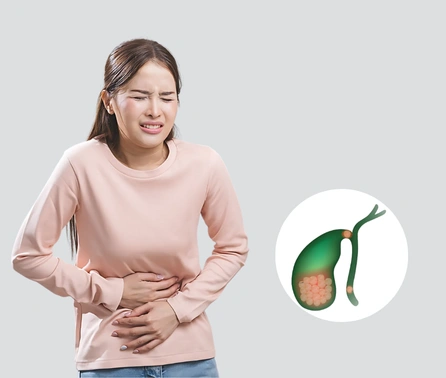
Treating Pigment Gallstones with Precision and Care
Pigment gallstones are tiny, dark-colored stones made mainly of bilirubin, a yellowish pigment of bile. They tend to occur in large quantities and are often associated with conditions that enhance the breakdown of red blood cells, including chronic hemolytic diseases. Pigment stones are also often found with liver illness and cirrhosis. Because of their composition and etiology, such stones have the potential to cause complications such as biliary obstruction and cholecystitis. Early diagnosis and treatment are necessary to relieve symptoms and avoid worsening of liver or biliary tract damage.
Get Appointment Watch Video Learn More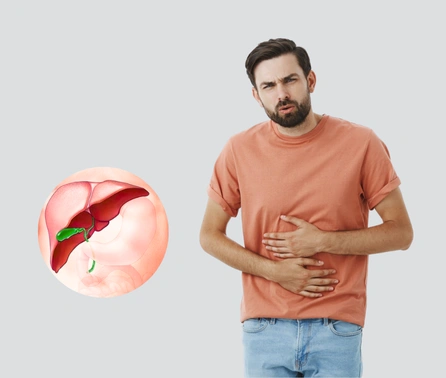
Emergency Care for Empyema of the Gallbladder
Empyema of the gallbladder is a severe infection where pus accumulates inside the gallbladder, leading to intense abdominal pain, high fever, vomiting, and general illness. This condition is often a complication of acute cholecystitis and requires urgent medical attention. Emergency laparoscopic cholecystectomy—the minimally invasive surgical removal of the gallbladder—is typically recommended to eliminate the source of infection, prevent rupture, and avoid life-threatening complications such as sepsis. Prompt treatment ensures faster recovery and reduces risks associated with untreated gallbladder infections.
Get Appointment Watch Video Learn More

Urgent Treatment for Mucocele of the Gallbladder
Mucocele of the gallbladder develops when a gallstone blocks the cystic duct, causing mucus to accumulate and the gallbladder to swell. This blockage prevents normal drainage, leading to increased pressure and distension. Mucocele is considered a medical emergency because the swollen gallbladder is at risk of bursting or perforating, which can cause severe infection and life-threatening complications. Prompt surgical removal of the gallbladder, usually through laparoscopic cholecystectomy, is essential to prevent rupture, control infection, and ensure a safe recovery. Early intervention significantly improves patient outcomes.
Get Appointment Watch Video Learn More
Managing Gallstone Pancreatitis for Optimal Recovery
Gallstone pancreatitis occurs when a gallstone obstructs the pancreatic duct, causing inflammation of the pancreas. This condition can be severe and life-threatening, leading to intense abdominal pain, nausea, vomiting, and digestive problems. Immediate medical intervention is crucial to manage inflammation and prevent complications like infection or organ failure. Treatment often includes medications to control pain and inflammation, intravenous fluids, and sometimes antibiotics. Surgical procedures or endoscopic techniques may be necessary to remove the gallstones and relieve the blockage, ensuring recovery and reducing the risk of recurrent pancreatitis.
Get Appointment Watch Video Learn More
Who are more prone to get gall bladder stone ?
- In female – Gallstones are found to be more common in women especially during and post-pregnancy.
- Obesity increases the risk of gallstones.
- Rapid weight loss can induce gall bladder stone formation
- Genetic factor
- Age - Underperformance of the liver
- Alcoholic and Smokers - Underperformance of the liver
Dr Shashank Shah at the Laparo Obeso Centre in the city extracted more than 1450 gall bladder stone
What are the symptoms of Gall Bladder Stone?
In some people, gall bladder stones may cause no signs and symptoms and the patient may be apparently asymptomatic. The symptoms may be vague like acidity, bloating, burning in chest, gaseous bloating or discomfort after meals and the person may not correlate them to gall stones. Patients with diabetes may not feel symptoms or the pain or symptoms may be masked due to diabetes. Hence, patients with diabetes are suggested to have gall bladder stones treated with laparoscopic cholecystectomy to prevent any emergency or complications.
In a case where gall bladder stone gets stuck in the cystic duct ( the duct or the small narrow tube which connects the gall bladder to the main biliary duct)and causes a blockage, it may cause blockage of the gall bladder leading to its distension, infection and the gall bladder may burst ( perforation) if not treated in time. If the stone gets stuck in the common or the main bile duct, bile can not pass into the intestine and hence jaundice develops. This type of jaundice is caused by obstruction to the flow of bile and hence it is called obstructive jaundice.
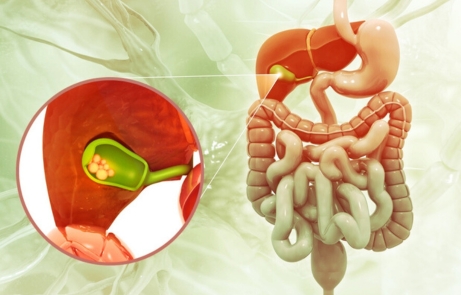
Common symptoms if the stone get stuck are:
- A sudden and rapid increase in the pain at the upper right portion of the patient’s abdomen
- A sudden and rapid increase in the pain in the centre portion of the patient’s abdomen, to be specific - just below the breastbone
- Back pain
- Right Shoulder Pain
- Nausea or vomiting
- Pain caused by the gall bladder stone may last several minutes to a few hours.
Treatment For Gall Bladder Stone
Patients experiencing symptoms from their gall bladder stones are recommended a gallbladder removal surgery. The gall bladder with stones inside is known as a diseased gall bladder and hence removal of gall bladder with stones is recommended scientifically. Only removal of stones is not recommended because the diseased gall bladder would form stones again.
The procedure is safe, effective and standardised. The surgery clears stones in the gallbladder but the stones in the common bile duct are removed endoscopically . Endoscopic removal of stones in the common bile duct is called ERCP.
Gall Bladder Stone Surgery
This surgery is also known as Cholecystectomy. It is performed to remove the gallbladder and gallstones by making multiple small incisions in the abdomen. Laparoscopic Cholecystectomy procedure is minimally invasive treatment option for removal of gall bladder stone and can be a day care procedure.
The procedure is performed under general anaesthesia and takes about 30 minutes or less in expert hands. The patient’s abdomen is inflated with carbon dioxide ( CO2 ) to get a clear view and expand the section.. Then, into the incision near the belly button, a lighted scope attached to a small video camera is inserted. Then the surgeon inserts surgical instruments through the other incisions to remove the gallbladder with the help of a video monitor guiding the surgeon
Surgeons at Laparo Obeso Centre use disposable bladeless trocars and advanced coagulating devices like Harmonic scalpel to dissect the gall bladder. The gall bladder removal from the attachments of liver can also be dissected with a diathermy which burns the tissues with an electric current and seals the vessels. Use of diathermy or cautery may be economical but with a chance of some thermal injury. To avoid this and to perform surgery with minimal tissue injury, minimal blood loss and less time, the procedure is always performed with Harmonic scalpel at Laparo Obeso Centre.
Bladeless disposable trocars induce minimal tissue injury with less pain and reduced chances of development of hernia at the site of puncture.
What to expect after the surgery ?
After the surgical procedure is performed bile starts flowing from the liver where it is produced, through the common bile duct and into the small intestine. After the gallbladder is removed, the bile produced in the liver flows normally into the intestines. This has minor or no effect on digestion in most of the patients. Most patients need a stay at the hospital for only 1 or 2 days after the procedure and can return to their normal routine in a day or twoThere are no diet restrictions after discharge from the hospital.
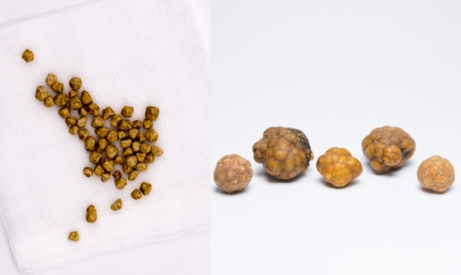
Are small stones risky or the large stones
Small stones or sand, often called as sludge on ultrasound have more risk of slippage into the bile duct causing obstruction. Small stones have a tendency to pass into the opening duct of gall bladder and tend to get stuck there, blocking the bile passage of gall bladder.
Generally, the symptoms may not be obvious to a patient. The symptoms could be vague like acidity, gases, indigestion, bloating or upper abdominal discomfort or backache.
On the other hand, large stones are equally risky and in the long run, they can induce ulcerations to the inner lining or mucosa of the gall bladder and in some, they may cause gall bladder cancer.
What are the advances in laparoscopic gall bladder surgery
The key hole surgery of gall bladder known as laparoscopic cholecystectomy can be performed using advanced technology and infrastructure and the patient can recover in a day.
At LOC , we use advanced Endo vision/ laparoscopy systems with use of ICG ( when required)which can delineate the anatomy of gall bladder very clear and can make the procedure of laparoscopic cholecystectomy very precise. Every operating room should have ICG or enhanced fluorescence imaging for laparoscopic biliary like cholecystectomy.
The laparoscopic cholecystectomy can also be performed through a single incision inside the naval. Tiny scar inside the naval becomes invisible over time and hence called No Scar surgery. Generally four tiny, 5mm to 10mm incisions are used.
At LOC, special needle instruments are used for surgery so that the number of punctures or incisions are reduced making it almost painless, scarless and day care procedure.
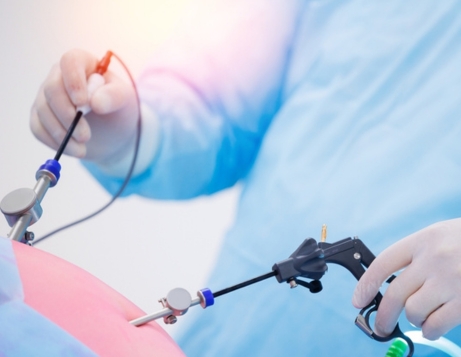
Common terms used by doctors, on sonography and CT scan:
- Acute cholecystitis: it means acute severe infection in the gall bladder, most often because of stones. Patient needs to be admitted and investigated.
- Chronic cholecystitis: chronic infection of the gall bladder . Sonography may show thickened gall bladder wall. Laparoscopic removal of gall bladder is the treatment of choice.
- Empyema of gall bladder: pus and infection in the gall bladder with signs of infection in the body like pain in abdomen, fever, vomiting, etc. Emergency laparoscopic cholecystectomy is usually advised.
- Mucocele of the gall bladder: It means that the opening duct of the gall bladder called the cystic duct is blocked due to a stone giving rise to distension of the gall bladder. The gall bladder contains white bile with mucous. Chances of gall bladder getting burst are high, perforation of the gall bladder. This is known as an emergency requiring surgery of the gall bladder
- Gall stone pancreatitis: This is the most concerning and life-threatening complication of gall bladder stones. This happens when a stone from the gall bladder passes into the common bile duct and gets stuck at the narrow opening of the duct into the intestines. The duct draining pancreatic juice also opens with the bile duct and hence the passage of pancreatic juice can get blocked. This blockage of pancreatic duct can give rise to inflammation of pancreas giving rise to pancreatitis. Pancreatitis can be severe and may be serios. Such patients may need an investigation called MRCP and stone is removed endoscopically. Laparoscopic removal of gall bladder is necessary after this procedure.
WHY CHOOSE LOC?
- Certified Centre of Excellence: Accredited by national and international bodies for advanced surgical practices.
- Cutting-Edge Infrastructure: We use the latest technology and equipment for precise and safe procedures.
- Swift Recovery & Personalized Care: Our expert team ensures a fast recovery and round-the-clock care.
- 0% EMI Facility: Making surgery affordable with no-cost financing options.
- World Record Holder: Our lead surgeon holds the world record for the youngest child to successfully undergo bariatric surgery.
- Cashless Facility Available for Hassle-Free Treatment
Our Advantages and Capabilities
| BENEFITS | LAPARO OBESO CENTRE |
|---|---|
| Fair Pricing | |
| Advanced International Procedures | |
| Cashless Insurance Claims | |
| No Cost EMI | |
| 100% Quality Result | |
| Strong Follow-up for Post Surgery | |
| Personalized Care | |
| Experienced Surgical Team | |
| State-of-the-Art Facilities | |
| Transparency with Patients | |
| Insurance Reimbursement |
Dr Sushilkumar Kharat
Dr Shashank Shah
Dr Poonam Shah
Meet the Experts in Gallbladder Surgery
Our center is led by a team of world-renowned Gallbladder surgeons with over 32 years of experience.
We’ve performed more than 1 lakh general surgeries and over 10,000 bariatric procedures, making us pioneers in the field. We are certified as a Centre of Excellence by the Obesity Surgery Society of India and the International Excellence Federation, ensuring the highest standards in care and expertise.
Get Appointment32+
1 Lac+
10,000+
100+
Expert Gallbladder Treatment for Faster Recovery
Bile is secreted from liver and carried to the intestine through the common bile duct. This secretion continues normally even after gall bladder and aids normal digestion. In most cases, normal digestion remains unaffected even after laparoscopic removal of gall bladder stones. In fact, with symptomatic gall stones, a fat free diet is advised to avoid stimulation of gall bladder and possible attack. However, after laparoscopic cholecystectomy, a normal diet can be resumed.
Yes, diet can be normal after laparoscopic gall bladder surgery.
The symptoms of gall bladder stones most often are non-specific. However, if a person has diabetes, severe obesity or medical risks, the gall bladder surgery should be performed electively to avoid any emergency. Gall stones may slowly grow and the number and cause obstruction to biliary tree in future. If the gall bladder wall is thick, it suggests that the gall bladder is diseases with multiple attacks of inflammation even though the patient has no symptoms.

“ I had galbladder stone from 2 years. And when attacks happened frequently i decided to go for surgery. Dr. Shashanks name came up and I went for my first appointment and in first meeting itself i decided to go for surgery after seeing the positive attitude of the Doctor. The operation went smoothly. And I am grateful to Doctor Sushil and Doctor Shashank. Personally my recovery was good, within 2 weeks i was feeling like my old self. Hospital rooms, staff and cleanliness was good. All the insurance process was also quick and response to any documents related query was also quick. Not much food options though for post surgery. “
“ I recently had laparoscopic cholecystectomy surgery, and my experience was excellent. After dealing with gallbladder issues for a while, I finally decided to proceed with the surgery, and choosing Dr. Shashank was the best decision I made. From our first consultation, his professionalism and clear explanations put me at ease. The surgery itself went smoothly, and I’m incredibly grateful to Dr. Shashank and Dr. Sushil for their expertise and care. The hospital environment was clean and well-maintained, and the staff were both courteous and efficient. The insurance process was handled swiftly, with no complications. I highly recommend Dr. Shashank, Dr. Sushil and their team for their exceptional service and care. “
“ I had gall stones . Had an central abdominal pain severe, It was complicated operation because my gallbladder was infected and ruptured, as other doctor advised me only dr.Shashank shah will do that. I got operated by dr.shashank shah and dr.sushil Kharat sir, the operation was complicated but due to best laparoscopic surgeon dr. Shashank shah and dr Sushil Kharat sir saves my life. It was key hole surgery. And day care procedure. Thanks to the best laparoscopic surgeon dr.Shashank Shah and dr Sushil Kharat sir. “
“ I had galbladder stone from 2 years. And when attacks happened frequently i decided to go for surgery. Dr. Shashanks name came up and I went for my first appointment and in first meeting itself i decided to go for surgery after seeing the positive attitude of the Doctor. The operation went smoothly. And I am grateful to Doctor Sushil and Doctor Shashank. Personally my recovery was good, within 2 weeks i was feeling like my old self. Hospital rooms, staff and cleanliness was good. All the insurance process was also quick and response to any documents related query was also quick. Not much food options though for post surgery. “

Sonali Fabwani

Ronit Anbhore

Akshaya Padate



